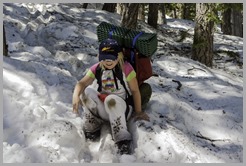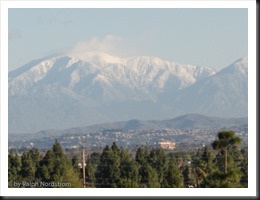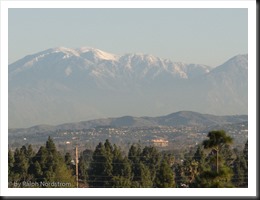Last year I started a series of articles under the general theme of Images with Impact. In it we are discussing things you can do with your images in Lightroom and Photoshop to enhance their impact. When I got to the topic of contrast I came to an abrupt halt. The more I thought about contrast, the more I wanted to begin that discussion with some real examples from nature. But to do that, I needed some photographs that illustrated what I wanted to share with you. And in Southern California, the types of photographs I wanted are only possible in winter. But it’s winter now. And I’ve been able to capture the photographs that I want, so now we’re picking up the series again.
What distinguishes a photograph created by the serious student of photography from one taken by a casual photographer? Many things to be sure. But one thing that stands out is a sense of clarity, a clear quality. The casual photographers’ photographs are just what the camera captures and are often like looking through a bit of haze and I don’t mean that they are out of focus. It’s the light. The effect may be subtle but it is very real. A more accomplished photographers’ photographs have a special quality to them, a quality that engages us, that draws us in and holds our attention. You might describe it as a crisp quality. (You can click on the photographs to enlarge them.)
(My daughter some years ago as we hiked out of a late spring backpacking trip in the local mountains.)
The serious student of photography skillfully applies contrast in the digital darkroom to achieve this look. But before getting in to how this is done, let’s step back and take a look at how we respond to contrast not only in photographs but also in nature.
In the following discussion I will use examples from nature to illustrate the affect contrast has on us. The idea is to understand how it works so that we can more effectively apply this knowledge to our photographs.
To illustrate what I want to share with you I looked for is a distant subject many miles away that can illustrate the affect that atmosphere has on contrast. And in this way we can explore together how we respond to the subject in different atmospheric conditions.
I actually have two excellent subjects available here in Southern California. To the southwest, out in the Pacific Ocean is Santa Catalina Island. To the north are the San Gabriel Mountains crowned by 10,000-foot Mount Baldy, officially known as Mount San Antonio. I chose Mount Baldy as my subject because it’s about 45 miles from the office building where I work (yep, I still have my day job). And I have a clear view of it from the 5th floor break room. So every morning when I get my coffee I grab a picture of the mountain. And in this way I’ve been able to photograph the mountain under a fairly wide variety of atmospheric conditions.
Before getting into the discussion of the images I’m about to show you, it’s worth mentioning the extent to which these photographs were post processed. They were all captured with the same exposure settings and all at the same time of day (morning). All were slightly overexposed. The post processing was done in Lightroom and consisted of cropping them and decreasing the Exposure setting to correct the slight overexposure, making them closer to that I experienced and giving them a consistent tonality. No other adjustments were performed.
Let’s start out with a comparison of the mountain taken on two different mornings.
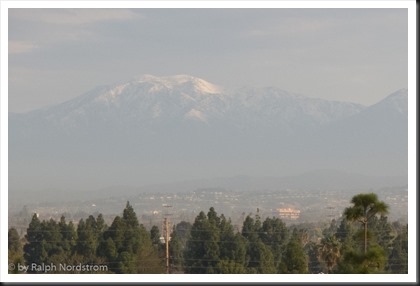 |
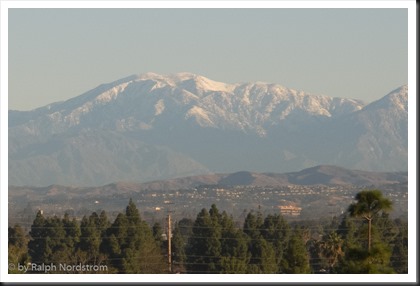 |
As you can see, the image on the left is hazy while the one of the right is much clearer. Taking a closer look one sees a number of key differences. The image on the left has a higher tonal value than the one on the right making it look washed out. The image on the right, besides the lower tonal values, has greater contrast resulting in deeper shadows (virtually missing from the left image) which brings out the detail of the many ridges and canyons that radiate from the summit.
Most people, when asked which image they liked the best, would pick the one on the right. We as humans have a strong response to contrast. Our attention is naturally drawn to areas of greater contrast. There is more visual information in these areas so there is more to engage us. In this case we can see the ridges and canyons that make the mountain look real. The image on the left is of a mountain but there’s very little visual information and therefore nothing to explore, nothing to grab our attention or interest.
Objects become sharper and more distinct, contrast increases as atmospheric haze diminishes. A side effect of that is that they also appear closer. We have a saying here in Southern California on those rare but wonderful crystal clear days in winter, “Wow, what a beautiful clear day. It’s so clear you feel like you can reach out and touch the mountains.” More haze creates the perception of depth, an illusion of a third dimension on a two-dimensional surface like a photograph. Less haze draws distant objects closer.
The Italian Renaissance masters developed this technique, the technique of using haze to create the illusion of distance. In fact, they give it a name – “sfumato” which roughly translates to “fume” or “smoke”. The Renaissance masters created this effect by blurring lines. Leonardo da Vinci was a master of the technique, one of his prime examples being the Mona Lisa.
There are couple more things to point out about atmospheric haze. Not only does haze increase tonal values and reduce contrast but it also imparts a color depending upon what’s causing the haze. Take a look at the photograph below.
In this photograph the haze has a blue cast. That’s because the atmosphere contains a lot of moisture. On days with water vapor in the atmosphere, the haze will be more blue because of the way water vapor scatters the reds and yellows and allows the blues to pass through. The blue haze obscures detail just like any other haze but in the digital darkroom we can use this knowledge to our advantage to bring out more detail in the mountains by desaturating the blue.
Let’s look at another example.
In this example, the haze is more yellowish or brownish. This is caused by dust or pollution in the atmosphere. In Southern California we are experts on dust and pollution. This type of haze can create spectacular sunsets but it’s not very good for photographs like this one.
An interesting observation is how blue haze reacts at sunset. A mountain or an island that’s been obscured all day by blue haze can suddenly become very visible and very distinct at sunset. This is because the light in Golden hour penetrates the blue haze, essentially eliminating it and revealing the object in startling detail. Understanding this gives us techniques that we can apply in the digital darkroom to bring out detail in distant objects.
So to recap, on hazy days distant objects look farther away. This is due to the fact that haze decreases contrast and increases the tonal value. This technique can be employed to make distant objects appear more distant and add depth to our photographs. But the lower contrast and higher tonal values deemphasize the object and makes it a non-dominant element in the composition. Clear days, on the other hand, give us lower tonal values, much greater contrast and more visual information. The effect is to make the object appear closer and, because contrast draws our attention, gives the object greater impact. Now it becomes an important element in the composition.
If we understand how we respond to contrast in nature, then we can use that understanding in our photographs to create the desired effect. We’ll talk more about how to do that in the next article.
Join me on one of my exciting workshops. Click here for more.
(405)

